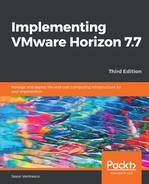The process used to create an Instant Clone desktop pool is similar to that used to create a linked clone pool. As discussed previously, it is assumed that you already have a virtual desktop master image that has the Instant Clone option enabled in the Horizon agent, and that you have taken a snapshot of that master image.
The following steps outline the process used to create the Instant Clone desktop pool. Screenshots are included only when the step differs significantly from the same step in the Creating a pool using Horizon Composer linked clones section:
- Log on to the Horizon Administrator console using an AD account that has administrative permissions within Horizon.
- Open the Catalog | Desktop Pools window within the console.
- Click on the Add... button in the Desktop Pools window to open the Add Desktop Pool window.
- In the Desktop Pool Definition | Type window, select the Automated Desktop Pool radio button, as shown in the following screenshot, and then click on Next >.
- In the Desktop Pool Definition | User Assignment window, select the Floating radio button (mandatory for Instant Clone desktops) and then click on Next >.
- In the Desktop Pool Definition | vCenter Server window, select the Instant clones radio button, as shown in the following screenshot, highlight the vCenter server, and then click on Next >:

- In the Setting | Desktop Pool Identification window, populate the pool ID:, and then click on Next >. Optionally, configure the Display Name: field.
- In the Setting | Desktop Pool Settings window, configure the various settings for the desktop pool. Many of these options are self-explanatory; those that are not are described in the Desktop pool common terms section of this chapter. These settings can also be adjusted later if desired. When finished, click on Next >.
- In the Setting | Provisioning Settings window, configure the various provisioning options for the desktop pool, which include the desktop naming format, the number of desktops, and the number of desktops that should remain available during maintenance operations. When finished, click on Next >.
- In the Setting | Storage Optimization window, we configure whether or not our desktop storage is provided by VMware Virtual SAN, and, if not, whether to separate our Horizon desktop replica disks from the individual desktop OS disks. When finished, click on Next >.
- In the Setting | vCenter Settings window, we will need to configure six different options that include selecting the parent virtual machine, which snapshot of that virtual machine to use, what vCenter folder to place the desktops in, what vSphere cluster and resource pool to deploy the desktops to, and what datastores to use. Click on the Browse... button next to the Parent VM: field to begin the process and open the Select Parent VM window.
- In the Select Parent VM window, highlight the virtual desktop master image that you wish to deploy desktops from. Click on OK when the image is selected to return to the previous window.
- In the Setting | vCenter Settings window, click on the Browse... button next to the Snapshot: field to open the Select default image window. Select the desired snapshot, and click on OK to return to the previous window.
- In the Setting | vCenter Settings window, click on the Browse... button next to the VM folder location: field to open the VM Folder Location window. Select the folder within vCenter where you want the desktop virtual machines to be placed, and click on OK to return to the previous window.
- In the Setting | vCenter Settings window, click on the Browse... button next to the Host or cluster: field to open the Host or Cluster window. Select the cluster or individual ESXi server within vCenter where you want the desktop virtual machines to be created, and click on OK to return to the previous window.
- In the Setting | vCenter Settings window, click on the Browse... button next to the Resource pool: field to open the Resource Pool window. If you intend to place the desktops within a resource pool you would select that here; if not, select the same cluster or ESXi server you chose in the previous step. Once finished, click on OK to return to the previous window.
- In the Setting | vCenter Settings window, click on the Browse... button next to the Datastores: field to open the Select Instant Clone Datastores window. Select the datastore or datastores where you want the desktops to be created, and click on OK to return to the previous window.
- The Setting | vCenter Settings window should now have all options selected, enabling the Next > button. When finished, click on Next >.
- In the Setting | Guest Customization window, select the Domain: where the desktops will be created, the AD container: where the computer accounts will be placed, and any other options as required. When finished, click on Next>:

- In the Setting | Ready to Complete window, verify that the settings we selected were correct, using the < Back button if needed to go back and make changes. If all the settings are correct, click on Finish to initiate the creation of the desktop pool.
The Horizon desktop pool and Instant Clone virtual desktops will now be created. To monitor the creation of the desktops, review the Monitoring the desktop creation process section of this chapter. Also located in this chapter is the Managing Horizon Desktop Pool Entitlements section, which outlines how to grant users access to the desktop pools that we have created.
